Articles
| Name | Author | |
|---|---|---|
| Case Study: PIC – Pilot in Command or Processor in Command? | Ping na Thalang, Vice President Information Systems Dept, Bangkok Airways | View article |
| White Paper: Business Intelligence – More than information alone | Gesine Varfis, Managing Consultant, Lufthansa Consulting | View article |
| White Paper: Fuel Efficiency through IT Support | Captain Marcel Martineau, President and CEO, TFM Aviation Inc. | View article |
| White Paper: Designing the Enterprise Solution | Lawrence A. ‘Bud’ Sittig and James R. Becker, Flight Guidance LLC | View article |
| Case Study: EFB – Posing Questions and Offering Answers | John Christian Paulshus, Head of Business Development Operational IT Solutions, Norwegian | View article |
White Paper: Designing the Enterprise Solution
Author: Lawrence A. ‘Bud’ Sittig and James R. Becker, Flight Guidance LLC
SubscribeDesigning the Enterprise Solution
Lawrence A. ‘Bud’ Sittig and James R. Becker, Flight Guidance LLC consider the Electronic Flight Bag and connected aircraft technology
There are very few remaining opportunities for the airline business to lower costs. The solutions that remain seem to fall into two categories. First are the straightforward physical solutions: make the aircraft more efficient with winglets, newer engines, or totally new airframes and systems. This path is conceptually simple, has been intensely analyzed and offers a well understood return on investment (ROI). The drawback is that the investment ranges from substantial to massive and the timescale for implementation stretches over decades. The second category of cost savings opportunities still available to most airlines is to improve operating procedures through better use of information and information technologies. These solutions range from obtaining departure clearances via Aircraft Communications Addressing and Reporting System (ACARS) to better use of Aircraft Condition Monitoring System (ACMS) and Flight operational quality assurance (FOQA) data to installing electronic flight bags (EFBs) to eventually, hopefully, someday using Automatic Dependent Surveillance Broadcast In (ADS-B In) and Controller Pilot Data Link Communications (CPDLC) procedures to make more efficient use of the airspace. All these solutions rely on the use of information technology to lower costs but are conceptually complex, require changing peoples’ behavior and generally have a less agreed upon and less clearly understood ROI than simple physical solutions. However the investment for the IT class of solutions is relatively modest, savings are very real and implementation can be accomplished in few months to a few years.
This article will focus on the use of electronic flight bags (EFBs) and ‘connected’ EFBs to improve operating procedures, thereby lowering costs. The authors have demonstrated that such solutions are available today, justifiable by cost and will allow an airline to reduce the costs and improve the safety of its operations. However the EFB solution remains a very flexible and fluid concept. It means different things to different airlines. Essentially, the EFB is a device to facilitate efficient operating procedures; which means that, just as procedures vary from airline to airline, so will EFB implementations. In addition, this class of solution is more of an information technology solution than a traditional avionics upgrade and thus has to be approached differently. Some regulatory guidance is available but not much. Just as the IT infrastructure of airlines will differ, so the EFB implementations among airlines will differ. Fortunately, over the past several years both the components and the understanding of how to implement an EFB solution have improved significantly. We will first describe the components of a complete EFB solution, then discuss the operational changes and improvements that can be obtained through implementing an EFB system and will conclude with a look at the future directions of EFBs.
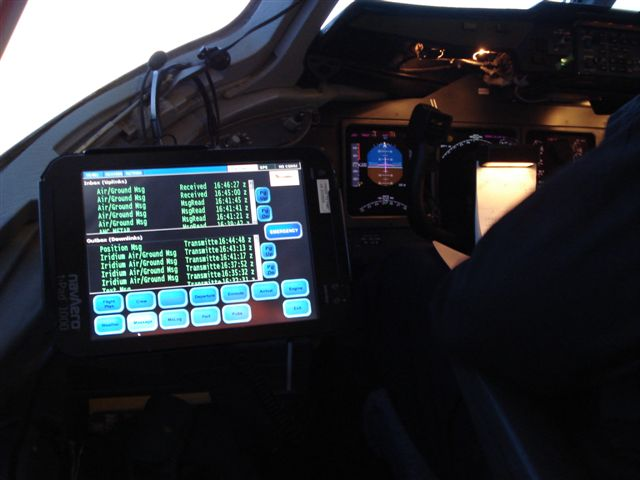
EFB in an MD-11 with messaging software
Electronic Flight Bag systems
The EFB came into existence at the same time as portable computers (laptops) became readily available. The electronic flight bag was conceived as a low cost, flexible, COTS (commercial off the shelf) computer that would enable the compact storage and display of the copious amount of paper that pilots have to carry on board. It was quickly realized that if the computer could be connected to some communications channel, it could serve as a terminal with a user interface that would be easier to use and more flexible than the character oriented Maintenance Control and Display Units (MCDUs) in use. The key concepts were low cost, good user interfaces and flexibility to add or modify applications as airline operational requirements required. The concepts of low cost and flexibility essentially translated into the requirement to avoid certification of the software under Radio Technical Commission for Aeronautics (RTCA) DO-178B at any higher level than ‘D’.
It wasn’t long before the FAA noticed the EFB trend and Federal Aviation Agency (FAA) Advisory Circular 120-76A was born which defined both Classes of EFB hardware and Types of EFB software.
Connected EFBs
EFBs, like personal computers, have to be connected to sources of data to be useful. Imagine how limited your personal computer would be if it could not connect to outside information.
At an absolute minimum, there has to be a way to connect the EFB to a ground based source of chart and pubs updates. The method of connection can range from ‘sneaker-net’ or manually loaded updates to connecting the EFB in the airplane, via a high bandwidth channel such as a cellular phone data channel (3G or GPRS or the coming 4G networks) or a WiFi network to a ground based server. The server contains the updates and allows the whole update process to run without human intervention. Whatever method is used, configuration control is a significant issue. For sneaker-net solutions, configuration control can be serialized USB sticks or some other manual process. With a network connection, configuration control can be done by software that automatically ensures that each EFB in the fleet has a copy of the appropriate information and easily displays the status of all EFBs in the system.
Once the challenge of updating charts and manuals has been solved, there is still more to be done in the communications area. While not mandatory, there is a very powerful reason to use an additional communication method that will allow the EFB to be electronically connected to the airline operations centers at all times. An ‘always connected’ EFB enables applications that can significantly improve airline operations and lower the cost of doing business. The connected aircraft becomes a node on the airlines’ network. This enables a real time connection to maintenance and a real time electronic log book (eTechLog). It also allows delivery of flight documents and release packages directly to the aircraft and a real time journey log. The operational improvements that can result from an always connected aircraft are significant and represent the current ‘cutting edge’ of operational efficiency.
So what are the practical means of connecting an aircraft? For the connection used to update charts and pubs on the ground, your choice is to use either cell phone or WiFi technology. While WiFi’s simplicity and bandwidth are attractive, unless the airline owns its gates or ramp area, WiFi becomes difficult to implement. It is a short range technology, the antennae are tricky and the airport is an electromagnetically noisy environment in the WiFi spectrum. Cell phone technology also has many issues but has been proven a generally reliable solution and the airline does not have to maintain the network. There are trade-offs to consider between using cell phone
adapters in each EFB versus wiring the aircraft with a central cell phone system. It is our opinion that any airline considering an EFB program should also invest in the necessary communications infrastructure and procedures automatically to update the EFBs. Otherwise you have added another task to Maintenance’s long list of minor tasks and you have saddled yourself with a nasty bookkeeping job.
For the airborne connection, the choices are: 1) Iridium, 2) Inmarsat Sat-Comm or other satellite vendors, or 3) cabin focused networks such as Air-Cell’s GoGo. This connection can be comparatively low bandwidth as the amount of data transmitted to/from airborne applications is relatively small.
Components for a complete EFB Solution
So, what does it take to have a complete EFB solution? What are all the pieces you need? This is not to be confused with the process of selecting and building an EFB system which will be discussed in a later section. There are four major categories of components:
- Airborne hardware: this includes the EFB (the display, the processor and the mounts), communications hardware (if any), and any additional kit such as aircraft interface hardware to read data from aircraft buses and/or network storage and server hardware that may be added. The table below gives the standard classification of hardware according to the FAA Advisory Circular 120-76A (see Table 1):
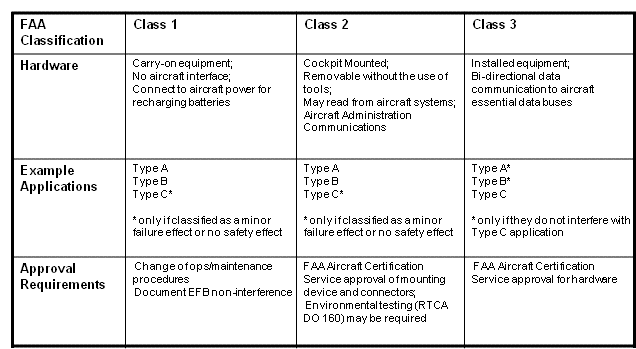
(Table 1)

navAero Class II EFBs installed in a B737
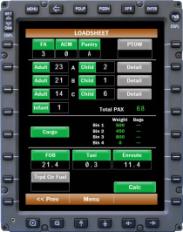
Class III EFB from Astronautics
- Software: both in the aircraft and on the ground. The aircraft software includes all of the EFB applications such as weight and balance calculators, performance calculators, etech logs, journey logs, document viewing programs, communications software as well as all the data such as charts and publications. The ground based software includes any communications interfaces as well as programs that ensure the airborne software is kept up to date. The following table gives the standard classification of software used in an EFB environment according to FAA Advisory Circular 120-76A (See Table 2)
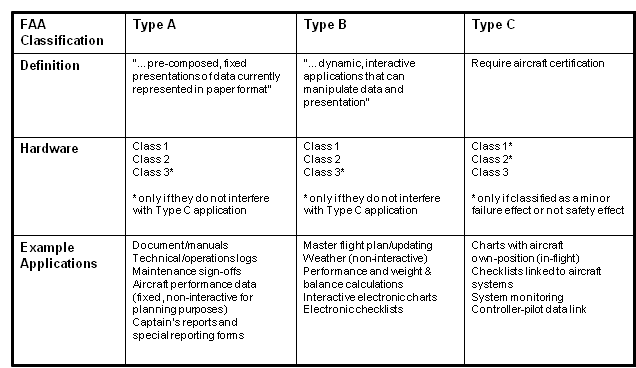
(Table 2)
- Communication Links: high bandwidth on the ground and perhaps lower bandwidth while in the air, as discussed above. The links imply service contracts with one or more link vendors.
- Services: this is a required piece of the puzzle and comes in several varieties:
- first are integration services. With the hardware, software and communications all coming from different vendors, someone has to be responsible for integrating the whole solution and making sure everything works, both initially and over the long run
- next you will need chart updating services, the electronic analog to your paper charts and…
- lastly you will need digital publication services either internally from your tech pubs departments or from outside vendors such as InfoTrust Group.
- Finally you will need to make choices on the services used in implementation of the program—those who will provide the engineering and who will provide the installation services.
As each airline will have a unique EFB program, each airline will make different selections in each of the four categories. One very important fact to keep in mind when planning is that this is an information technology (IT) solution, not an avionics solution. Actually it is an IT solution in an aircraft environment so the solution will be a bit of a hybrid. Several characteristics of IT solutions that are important here include: 1) the hardware useful life is 3 to 5 years, 2) the software will be upgraded almost continually, 3) you never have enough bandwidth and… 4) the vendors with the best solution change over time. This is very different from the avionics environment where you expect 20 years of life from a system and relatively few updates along the way. So the fact that you are dealing with an IT solution affects almost every decision you make, ranging from how to structure the STCs to the choice of vendors to how you wire the aircraft. At the beginning of the program it is important to take the time to design the architecture of your system to accommodate the inevitable change that occurs with any IT system. This applies to both the hardware and the software.
EFB technology and new operational capability
Imagine having your laptop in the aircraft with you, connected to the Internet and fully functional. Virtually any capability you have on your laptop is now available in a Class II and III EFB mounted on the flight deck and connected to a communications network. Enhanced functionality and capability is brought to the flight deck, Flight Operations back offices and the Maintenance and Engineering division. Software applications and functionality for Flight Ops and Maintenance are growing nearly as fast as new apps from the App Store. A Class II or III EFB solution mounted on the flight deck will provide a direct link to the airline Operations Control Center (OCC) and all the support systems therein. The flight deck crew can check in for their rotation directly from the aircraft and will be entering the flight and journey log data within minutes of boarding. The flight dispatch release, weather package, NOTAMs and all related dispatch data can be delivered from the OCC wirelessly to the EFB providing the crew with necessary documents and data for dispatch. This has been demonstrated in the US and approved under CFR Part 121 Op Specs by the FAA. Additional capability provided by the EFB can include:
- Performance calculator for take-off, en-route, landing and go-around (data derived from software algorithms);
- All aircraft flight manuals;
- Flight Operations Manual (FOM);
- Company Standard Operating Procedures (SOP);
- Maintenance manuals;
- Minimum Equipment List (MEL) and CDL;
- Navigation charting for en-route, terminal and approach (Jeppesen, LIDO, NavTech);
- NOTAMS;
- Weather;
- Aeronautical Information Publications and Manual (AIP and AIM);
- Flight Crew qualification logs, flight time/duty time logs, Captain’s incident or safety reporting forms;
- Flight Attendant Manual;
- NASA Aviation Safety Reporting forms;
- Power settings and cost indexing;
- Oceanic navigation plotting and recording;
- Electronic checklists;
- Cabin mounted video for security surveillance camera display;
- Software applications to support Internet and other operational communications to support airline operational control, flight following and position reporting;
- Maintenance log book (electronic logbook capability) fully integrated with back office maintenance information systems;
- Real-time data link of aircraft engine and systems exceedances;
- Data download from aircraft avionics busses directly to Maintenance Control, back office archives and vendor data banks;
- Flight Operations Quality Assurance (FOQA) data wireless downloads directly to the vendor or Flight Safety offices;
- Cabin discrepancy eLog management and eCabin passenger service interface;
- Fuel management software and fuel upload reconciliation;
- Emissions reporting.
While there are no ‘killer apps’ that alone carry the business case, perhaps the capability that approaches that level is the electronic logbook (eTechLog). A well designed eTechLog with software customized to the airline will fully replace the paper technical logbook and all the challenges of paper systems, data entries, archiving and data retrieval. The eTechLog can provide real time notification of discrepancies while aircraft are in flight allowing down station maintenance teams to begin managing the discrepancy well before the aircraft arrives. eTechLog software can be customized to well defined fault reporting codes, enhancing user interface and reducing time for pilot or maintenance technician entries while improving accuracy in discrepancy reporting, repair and documentation. Removing paper from the maintenance administrative process can by itself be an extraordinary enhancement to productivity, efficiency and cost control.
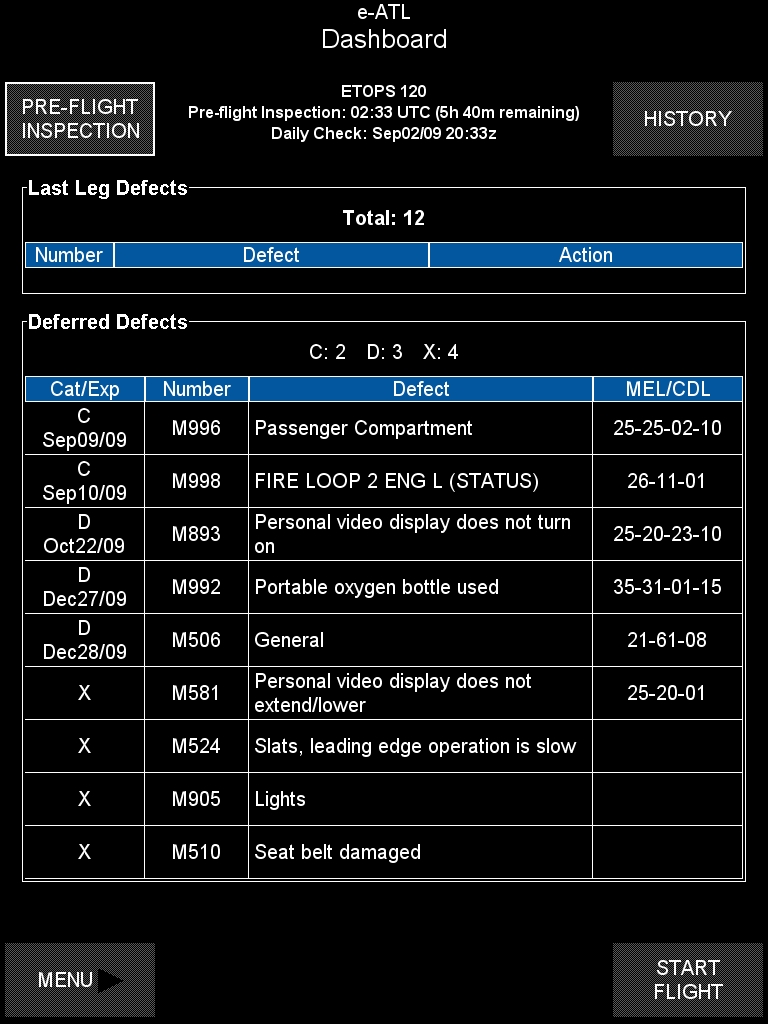
A screen from an eTech Logbook from Ultramain
The Class II and III EFB on the flight deck can significantly enhance flying safety by displaying ‘own-ships position’ on the ground reducing the potential for runway incursion and ground collision. Further, the Class III EFB with a certified operating system and certified software can provide ‘own-ships position’ while in flight increasing pilot situational awareness and safety.
Hardware and software vendors continue development work for an ADS-B In solution hosted on a Class III EFB. Limited application of the ADS-B In functionality is already being demonstrated on EFB’s in the US in prototype installations. Once the ADS-B In capability is fully integrated into the EFB, operators will have another solution for adding this air traffic management and surveillance system mandated by 2020 under NextGen.
Architecture and design phase — the road map
The architecture and design of an EFB/Connected Aircraft solution will vary with every Operator. One of the most critical phases in the evolution of an EFB system in your operation is defining the goals, both short term and long term, of this unique IT system. You will need to ask; what functional areas of the airline will use the system, i.e. who are the major players: Flight Operations; Maintenance and Engineering; Cabin connectivity and Flight Attendant usability; Technical Publications library or Marketing? What business processes will be affected or driven by this technology within these functional areas? It can be easily demonstrated that the broader the application and functionality of the EFB system across the enterprise, the better the business case becomes. If the Flight Operations division drives an EFB solution for only the Flight Ops area to support nav. charting, and performance, weight and balance calculations, it will be difficult to show a return on investment. But designing the system with an electronic log book that provides tactical, real time maintenance management in line operations plus a full integration with back office maintenance information systems, rapidly improves the business case and the ROI. Bringing Cabin Services and airline marketing concepts into the architecture further enhances the ROI and can lead to a competitive advantage. Designing a system across the airline that uses open architecture and is scalable will provide greater flexibility in responding to changing business processes and maturing technology over time.
Defining the business case, as in any capital investment in the airline, is the major hurdle for the operator considering the EFB/Connected Aircraft solution. The airline must identify a ‘Champion’, ideally at the Vice President level, to drive the case and define the productivity enhancements, cost savings and capability of the Connected Aircraft. Selecting subject matter experts within each functional area of the airline will be important. Each SME will need to analyze current business processes against the potential efficiencies and productivity enhancements within their areas to get to a satisfactory ROI in reasonable time to justify the capital spend. Getting the business case for an EFB/Connected Aircraft solution past the CFO, CEO and perhaps the Board of Directors will make the rest of the installation and integration phase of the project look easy.
Once the business case is made and funding is allocated, it is decision time for selecting software, hardware and communications systems that will support the goals and business processes identified in the design phase. The industry vendor list supporting these areas has grown in recent years as EFB solutions have gained traction in the industry. Selecting a vendor who will become a committed partner in achieving the design goals for your airline will be important to the longer-term success of the project. Service and support negotiated into the commercial agreements will ensure long term commitment for a technology that is continually evolving.
As decisions are reached in software, hardware and communications infrastructure, the implementation phase begins with engineering and software integration and development. Here is where the vendor teams will come together to solve the challenges of integrating hardware systems with a variety of software applications communicating through a common network that is both airborne and ground based.
Process change happens quickly as installation and implementation bring the technology to line operations. Training programs for all functional areas need to be in place to support the end users of the EFB/Connected Aircraft technology. At the end of the day, all of the design, hardware, software, communications network and procedures must receive approval from the Regulatory Authority. It cannot be overstated that the operator’s regulatory oversight team (Principal Inspectors under the FAA) must be a partner in the EFB/Connected Aircraft solution from the early design stages. A steep learning curve awaits everyone embracing EFB technology. Regulators must be an integral part of the process as they build their knowledge base of the technology that the airline will implement. This limits surprises and delays in approval of the airline’s Operations Specification (OpSpec) authorizing the use of wireless and paperless electronic media when the program is fully operational.
Implementation Challenges
As with any major capital project, countless challenges will be encountered in the design, integration and implementation of an EFB/Connected Aircraft solution. These challenges can be mitigated with a well thought out design embraced by all stakeholders. Key areas for emphasis as you begin the design phase of the EFB/Connected aircraft project include:
- Building a cross functional team. Generally, one division of the company will emerge as the advocate for EFB technology and will become the driver for the early study and research. But other functional areas should be brought into the study phase to ensure support across the enterprise. This becomes critical as the business plan is developed and broader application of the connected aircraft potential can be demonstrated. At a minimum, the team will include Flight Operations, Maintenance and Engineering, IT, Technical Publications, Cabin Service and Marketing. And don’t leave out the Regulators. Flight Operations is frequently the early driver in adopting EFB capability within the airline but one of the most powerful capabilities offered to the enterprise is the electronic logbook software that can revolutionize the Maintenance and Engineering way of conducting line operations and back office data management.
- Building a strategic plan from the architectural phase to final implementation. A well thought out strategy based upon cross functional goals will ensure buy-in with everyone pulling in the same direction to get the technology in place. An open architecture with scalable design will provide flexibility and growth potential as this ever changing technology matures over time.
- Developing the business case that will sell the solution. The broader the functionality designed into your airline’s EFB/Connected Aircraft solution, the easier the business case is to make. Using EFB only for nav. charting and performance calculations on the flight deck will be hard to sell but add an eTechLog capability and connect the aircraft through a communications infrastructure and the case will show worthwhile return on investment while enhancing and revolutionizing business processes across two operational divisions.
- Establishing an EFB Office led by a subject matter expert and advocate for EFB technology. While cross divisional support is essential, one area needs to lead the charge for the strategy all the way through implementation. A Champion at the executive level will be critical for sponsoring this complex plan through business case development and up the corporate approval chain to full funding. Further, the regulators will want a single point of contact to deal with at the operational level. The EFB Office will become that focal point.
- Leading change management. A comprehensive, fully integrated EFB/Connected Aircraft solution will bring change across the operating units of the enterprise. ‘The way we’ve always done it’ syndrome will need to be overcome. This is a leadership issue and one that can be managed by good communication and thoroughly developed training programs for end users. No paper on the flight deck and digital sign-offs of the airworthiness log on the flight line, among countless other wireless/paperless enhancements will pose challenge for many who have operated in conventional ways for much of their careers. Leadership and training will be the key to overcoming resistance to change.
- Dealing with the Authorities. The Regulatory Office holding your airline’s certificate should be involved with the plan from the earliest stages of design. These are the Principals who will ultimately approve the architecture, implementation and operational use of the solution. The complexity of the solution requires active engagement of the authorities throughout the development of this revolutionary technology. At the end of the day, Op Spec approval will come much easier when the principals are knowledgeable and confident of the technology, training and execution plan.
Future directions in Electronic Flight Bags
If you had asked us a year ago, we would have said that a traditional, purpose built Class II EFB solution with a high bandwidth connection while on the ground and a low to medium bandwidth connection while in the air was clearly the way to go. Several vendors are offering excellent Class II solutions and the software is getting better both in terms of functionality and overall reliability. However in the past year two new trends have developed; one that drives the EFB solution more towards a traditional avionics program and one that significantly lowers the cost of an EFB solution while offering potentially Class I or II functionality.
The first trend is driven by the need to retrofit ADS-B In functionality into the fleet of aircraft. A large portion of ADS-B In functionality requires a display in the cockpit to present information about surrounding traffic. The benefits of this technology only occur when a high percentage of the fleet is equipped; and delivering these benefits is central to both the NexGen and Single European Sky ATM Research (SESAR) programs in the US and Europe. Both the FAA and EUROControl are discussing the possibility of using EFBs, connected to the traffic alert and collision avoidance system (TCAS) avionics, to display this information in order to create a solution that can be retrofitted. UPS is demonstrating some of this functionality at Louisville and jetBlue is also equipping a portion of its fleet to test and demonstrate ADS-B In capabilities. It requires a Class III EFB running operating software that has been developed according to the requirements of DO 178B, level C. This eliminates EFBs that use Windows as their operating system and creates significant issues when mixing uncertified Type A and B applications with certified Type C applications on the Class III device. These issues are solvable with either hardware or software solutions and various vendors are working on the new products that meet these enhanced requirements. So one possible path an operator can take is to purchase and install one of these new Class III systems, run Type A and B applications on it to achieve the efficiencies in their operation and then, when the ADS-B In applications are ready, upgrade the system to run the Type C applications as well. The good news is that the price of Type III systems has come down substantially and that one gets a very solid, purpose built unit that may last a long time.
The second trend is driven by the introduction of the iPad and other tablet computers. The iPad, from a user’s point of view, is almost an ideal EFB though it does not provide the fully integrated Connected Aircraft solution. However, the combination of low cost, compact form factor and great functionality is very tempting. Geo-referenced en-route charts and approach plates are already available in the iPad and are being used by GA pilots. In the US, the FAA has approved the iPad for use in some Part 135 operations. We have talked with several Part 121 operators that are considering the iPad for various roles. It makes the perfect back-up for conventional EFBs should one or both fail. This can simplify the process for developing MEL dispatch relief if EFB systems become degraded. Create the right mounting bracket and power cables and the iPad can become a suitable, low-end Class II unit. There is a valid question about the iPad’s ability to stand up to everyday use but even with a one year life cycle, you are probably ahead of the game financially. Assuming all the issues with the tablets can be solved, a Class II EFB with a base price of $600-$800 will be tremendously attractive. An iPad or similar tablet computer can provide an entry point into EFB/Connected Aircraft technology with scalable growth to a more sophisticated wireless/paperless capability.
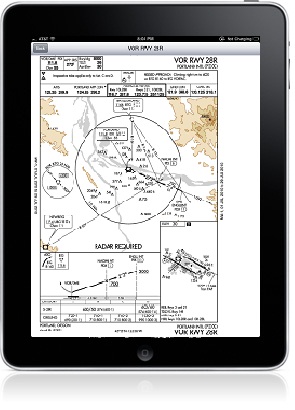
An iPad displaying approach plates. The future of EFBs?
EFBs are like IT solutions in another way. If you wait a year, there will be better ones available. However, you will have missed a year of lower cost structure and more tightly coordinated operations. The key is to embrace an open architecture that provides flexibility for future upgrade and functionality. View EFBs as another step in building out your IT infrastructure. Build a plan, fund the plan and get started.
Comments (0)
There are currently no comments about this article.

To post a comment, please login or subscribe.